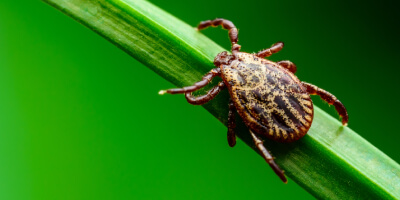American Dog Tick Removal
Knowing how to identify a tick is your first step to controlling it.
What Do American Dog Ticks Look Like

Oval and flattened in shape, American dog ticks are brown with whitish to gray markings. As larvae, they have six legs while nymphs and adults have eight. These extremities allow them to effectively crawl through their environment, as well as animal fur and human hair. Depending on whether or not they have fed on host blood, American dog ticks can range in size from 5 mm to 15 mm.
Also known as the wood tick, the American dog tick got its name from the fact that adult ticks prefer to feed on domestic dogs and that this particular tick species is only found in North America. The American dog tick is a member of the hard tick family, meaning that it possesses a hard exterior shield. American dog ticks are known to harbor bacteria responsible for causing diseases in humans such as Rocky Mountain spotted fever, which is spread when they suck blood from their host. Exposure to these ticks is most likely to occur during spring and early summer.
Not the tick you have?
Also known as the wood tick, the American dog tick got its name from the fact that adult ticks prefer to feed on domestic dogs and that this particular tick species is only found in North America. The American dog tick is a member of the hard tick family, meaning that it possesses a hard exterior shield. American dog ticks are known to harbor bacteria responsible for causing diseases in humans such as Rocky Mountain spotted fever, which is spread when they suck blood from their host. Exposure to these ticks is most likely to occur during spring and early summer.
Not the tick you have?

When they are ready to lay their eggs, adult female American dog ticks will detach themselves from their hosts and search for a suitable egg-laying location. Over 14-32 days, she will lay as many as 6,500 eggs and then die. The eggs typically hatch in 36-57 days, during which time the larvae emerge and seek out small hosts, such as mice. Engorgement often requires six days, but the larvae can survive up to 584 days unfed. After sufficiently feeding, they will drop off of the host and look for a place to molt into nymphs. This process usually takes about 24 days. Depending on the climate, the entire lifecycle of an American dog tick (egg to egg) can take anywhere from three months to more than one year. In the northern United States, it’s common for the lifecycle to last two years.
Where Are American Dog Ticks Found
These ticks prefer grassy areas with low vegetation where larger mammals pass by. American dog ticks do not survive well indoors. It is thought that American dog ticks are attracted by the scent of animals, so they are common along roads and trails. These pests thrive in areas where grasses, bushes and plants are accessible to humans. While American dog ticks choose habitats that maximize their exposure to potential hosts, they can survive for about 2-3 years (1,053 days) unfed. Adult American dog ticks prefer to bite domestic dogs and can therefore be brought into the home and potentially transferred to humans.
How Did I Get American Dog Ticks
Homeowners with outdoor pets and tall grass are at higher risk for coming into contact with American dog ticks. Unless you have tick treatments done, you won’t be able to not have them. Keeping the grass around the home well-trimmed can help but even then you should always inspect pets and people closely after outings. If you suspect a tick problem on the property, contact us to come in and deal with your tick problem.
what Problems do american dog ticks cause
The American dog tick is the primary vector of Rocky Mountain spotted fever (RMSF), which is caused by the bacterium Rickettsia rickettsia. According to the CDC, Rocky Mountain spotted fever has been a nationally recognized condition since the 1920s. Symptoms of Rocky Mountain spotted fever include high fever, chills, muscle aches, and headaches. A rash that may spread across the extremities occurs in some cases. It usually develops 2-4 days after the fever begins. The disease is treated with antibiotics, but can be fatal if left untreated.
Another disease American dog ticks are known to transmit is tularemia, which is caused by the bacterium Fracisella tularensis. It is transmitted from rabbits, mice, squirrels, and other small animals. Symptoms include fever, chills, and tender lymph nodes. An ulcer may form at the tick bite site.
In addition, American dog ticks can cause tick paralysis, which can lead to severe respiratory distress and muscle weakness in those affected. If you believe you have contracted one of the American dog tick diseases mentioned above, please call a healthcare professional. To avoid all this, it would be best to call in a professional pest control company to provide you with tick treatments that will result in ultimate tick control.
Another disease American dog ticks are known to transmit is tularemia, which is caused by the bacterium Fracisella tularensis. It is transmitted from rabbits, mice, squirrels, and other small animals. Symptoms include fever, chills, and tender lymph nodes. An ulcer may form at the tick bite site.
In addition, American dog ticks can cause tick paralysis, which can lead to severe respiratory distress and muscle weakness in those affected. If you believe you have contracted one of the American dog tick diseases mentioned above, please call a healthcare professional. To avoid all this, it would be best to call in a professional pest control company to provide you with tick treatments that will result in ultimate tick control.
How Can I Prevent American Dog Ticks
In order to avoid being bitten by an American dog tick, apply an insect repellent containing an EPA-registered ingredient, such as DEET, picaridin, or oil of lemon eucalyptus. Also, consider wearing long sleeved shirts and pants, preferably light colored so ticks will be easy to detect, and tuck your pants into your socks. This may not be a practical solution during the hot and humid Connecticut, New York, New Jersey, Pennsylvania, and Delaware summers, though! The best thing you can do is inspect clothing and skin on pets and all people after being outside. Immediately wash any clothes worn outside.
If you have a bite from an American dog tick, use fine-tipped tweezers to grasp it as close to the skin’s surface as possible. Pull upward with steady, even pressure. Don’t twist or jerk the tick as this can cause the mouthparts to break off and remain in the skin. Once the tick is removed, thoroughly clean the bite site with soap and water. Then, flush the tick down the toilet or wrap it in a tissue before disposing in a closed receptacle. You could also save the tick in a sealed bag to be tested for any potentially harmful bacteria.
If you have a bite from an American dog tick, use fine-tipped tweezers to grasp it as close to the skin’s surface as possible. Pull upward with steady, even pressure. Don’t twist or jerk the tick as this can cause the mouthparts to break off and remain in the skin. Once the tick is removed, thoroughly clean the bite site with soap and water. Then, flush the tick down the toilet or wrap it in a tissue before disposing in a closed receptacle. You could also save the tick in a sealed bag to be tested for any potentially harmful bacteria.
Why Western for american dog tick control
We’re passionate about controlling ticks around your home or business because we live and work here – it’s our neighborhood, too. With our almost 100 years of experience keeping homes and businesses in Connecticut, Delaware, New Jersey, New York, and Pennsylvania safe from pests, Western has the experience you can trust.
100% Satisfaction Guarantee
24-Hour Guaranteed Response
Board Certified Entomologists
Say goodbye to American dog ticks.
GET MY QUOTE
